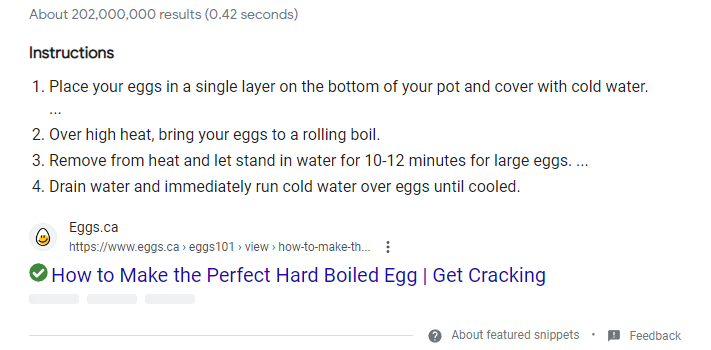How to Optimize Your Web Page for Zero-Click Snippets
Have you ever searched for something like “How to Boil Eggs” on Google and found all the information you needed right there on the search results page, without having to click through to a website? That’s called a zero-click snippet, and they are becoming increasingly popular and will continue to grow in 2023.
Zero-click snippets, also known as featured snippets, are a type of search result that provides a concise answer to a user’s query right on the search results page. They appear at the top of the search results, above the organic results and any paid ads. Zero-click snippets can come in many different formats, such as paragraphs, lists, tables, and even videos.
As a website owner, you might be wondering how you can optimize your web pages to appear in these zero-click snippets. After all, getting featured in a zero-click snippet can significantly increase your visibility and traffic. Here’s how to do it:
1. Identify Relevant Queries
The first step to optimizing for zero-click snippets is to identify the queries that are relevant to your content. Think about the questions your target audience might be asking and what information they might be searching for. Use tools like Google Search Console and SEMrush to identify the queries that are driving traffic to your site and those that you’re already ranking for.
2. Create High-Quality Content
Once you’ve identified the relevant queries, it’s time to create high-quality content that answers those queries concisely and comprehensively. Your content should provide a clear and concise answer to the user’s question, ideally in 40-50 words or less. Use simple language and provide specific examples or data to support your answer.
3. Optimize Your Content for Featured Snippets
To optimize your content for featured snippets, you need to structure it in a way that makes it easy for Google to understand and display. Here are some tips:
Use header tags (H1, H2, H3) to break up your content into sections and sub-sections.
Use bullet points or numbered lists to present information in an organized and easy-to-read format.
Provide clear and concise answers to the user’s query.
Use descriptive and informative page titles and meta descriptions.
4. Implement Schema Markup
Schema markup is a type of structured data that helps search engines understand the content on your web page. By implementing schema markup, you can provide additional information to Google that can help your content appear in zero-click snippets.
There are many different types of schema markup, but the most common ones for zero-click snippets are:
How-to schema markup: This is used for step-by-step guides and tutorials.
FAQ schema markup: This is used for frequently asked questions and their answers.
Recipe schema markup: This is used for recipes and cooking instructions.
5. Monitor Your Results
Once you’ve optimized your content and implemented schema markup, it’s important to monitor your results to see if you’re appearing in zero-click snippets. Use tools like Google Search Console and SEMrush to track your rankings and traffic.
If you’re not appearing in zero-click snippets, don’t worry. Keep optimizing your content and experimenting with different formats and structures until you find what works best for your audience.
In conclusion, optimizing your web page for zero-click snippets can significantly increase your visibility and traffic. By identifying relevant queries, creating high-quality content, optimizing your content for featured snippets, implementing schema markup, and monitoring your results, you can increase your chances of appearing in zero-click snippets and driving more traffic to your website.
